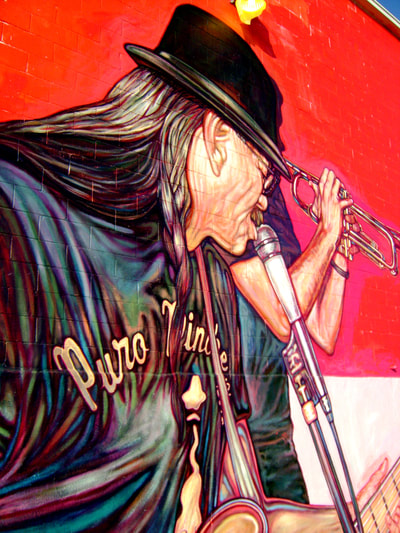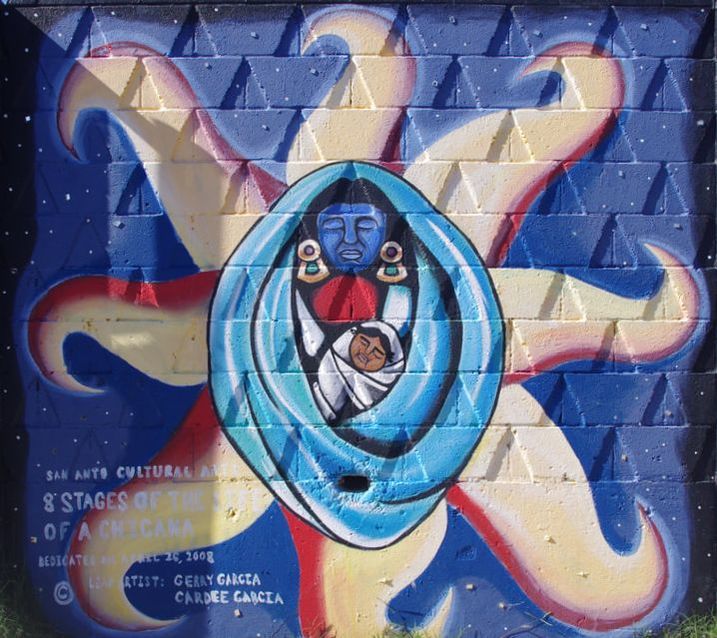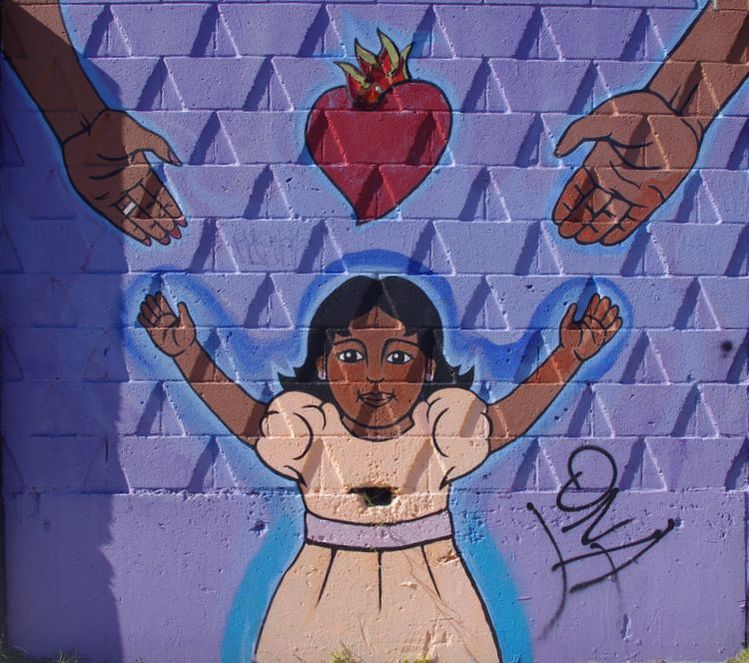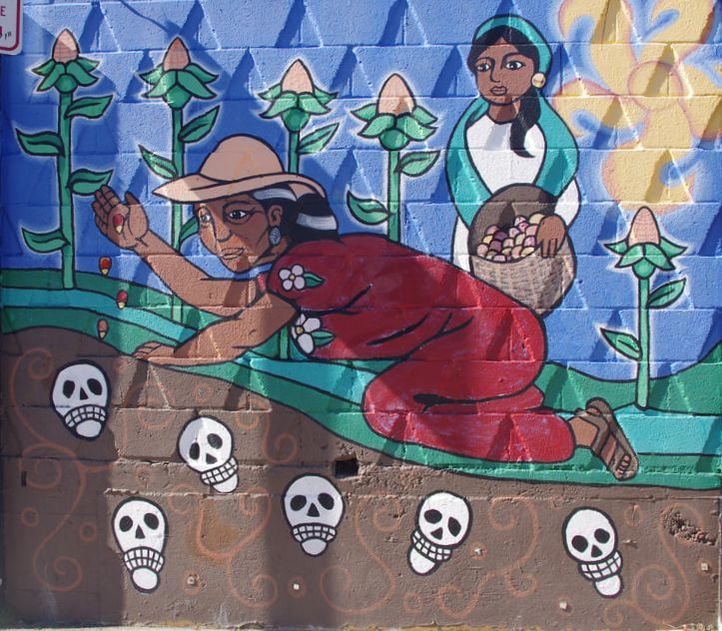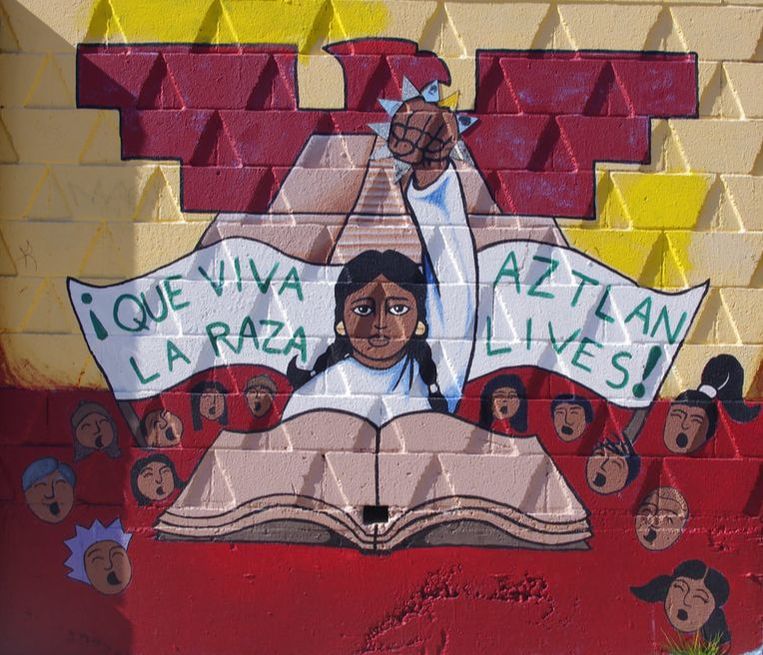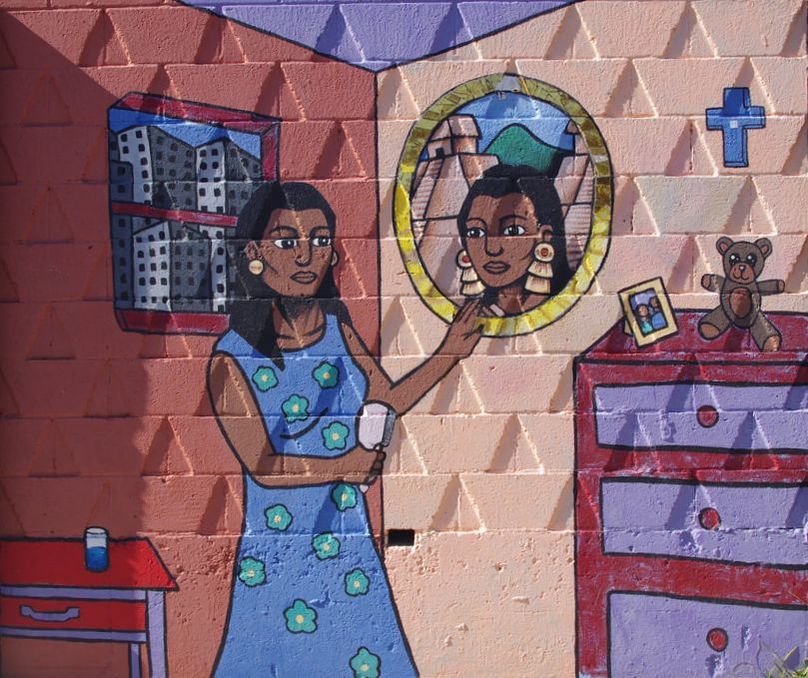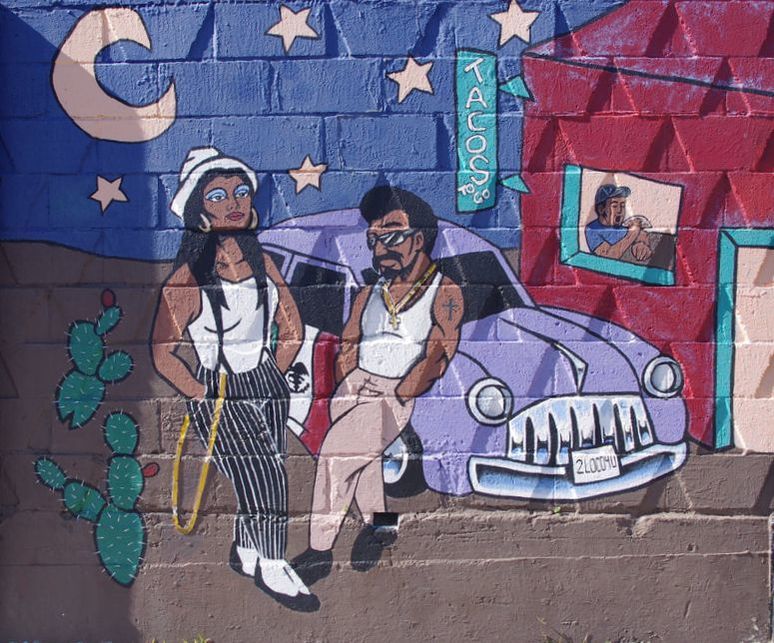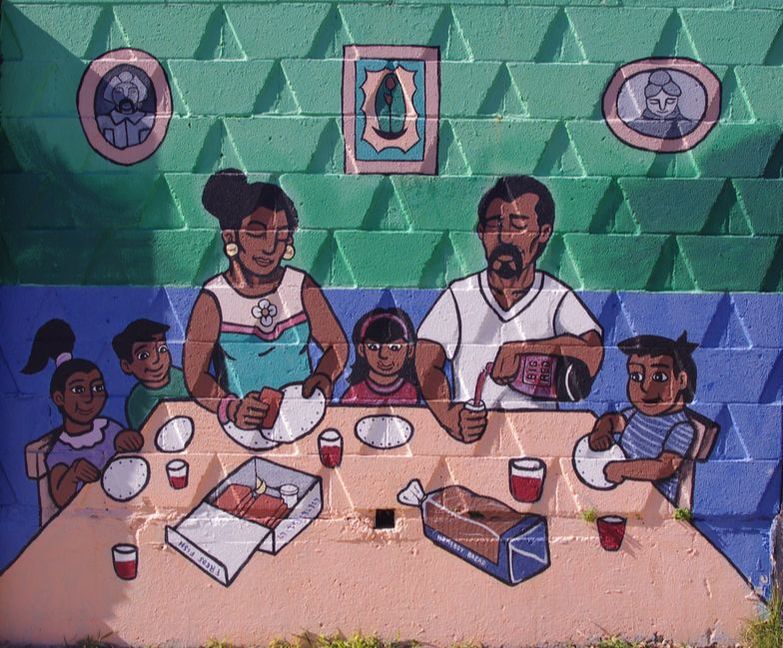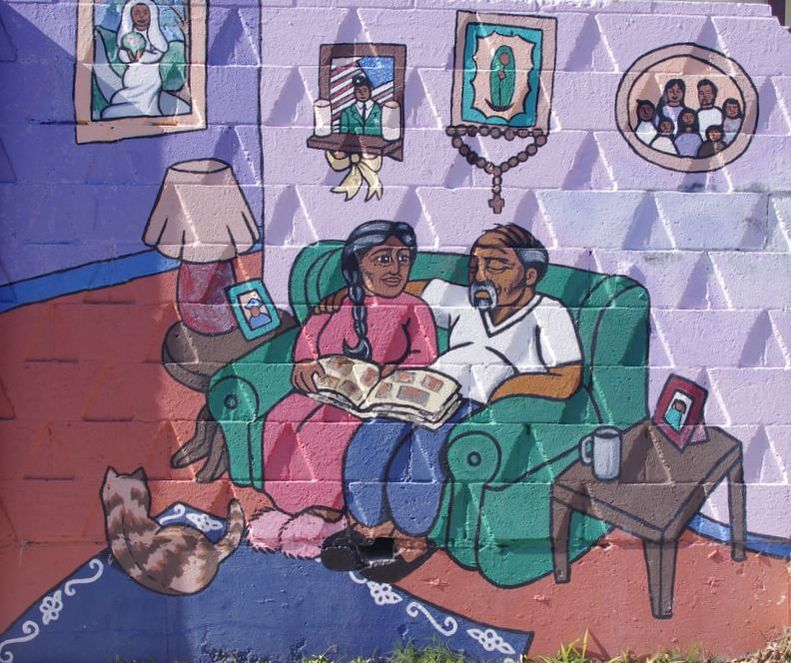#3 - 8 Stages in the Life of a Chicana
|
Location: 1250 S. Trinity St Dimensions: 81'4" x 8' Original date: December 1995 Original artists: Cruz Ortiz, Carlos Espinoza Restoration 1 date: 2004 Restoration 1 artists: Cardee and Gerry Garcia Restoration 2 date: 2017 Restoration 2 artist: Adriana Abundis and youth volunteers |
Painted on eight different sections of a fence on Trinity Street, Eight Stages in the Life of a Chicana tells the life story of a chicana from the Westside. Cruz Ortiz designed the original mural in 1995 and Gerry and Cardee Garcia updated the mural in 2004. Gerry and Cardee stayed true to the original design but made some edits to emphasize the chicana’s strength, such as by raising her fist in the fourth panel and making her portrait more prominent than her vato’s in the sixth panel. The biggest difference is in the eighth panel, which originally showed the chicana and her comadre drinking coffee on the front porch. A happily married couple, Gerry and Cardee changed the image to show that the chicana and her husband grew old together.
Compare Original and Restored Mural Panels
|
|
Content and Design
From left to right, the mural reads like a public picture book:
|
4. Politicization: The chicana is a student becoming conscious of her identity, a process of education represented by the book in front of her. She is proud to be brown and raises her fist as she becomes a leader for other chicanas and chicanos. An Aztec temple and United Farm Workers (UFW) flag stand behind her. |
History
The original Eight Stages was dedicated on December 23, 1995, a Christmas gift from San Anto Cultural Arts to the barrio. Designed by Tony “Cruz” Ortiz, the mural was painted by a crew of youth artists from the Alazan-Apache Courts. Gerry and Cardee Garcia obtained permission from Cruz Ortiz to revise the mural. The most significant change is in the eighth panel, which originally showed the chicana and her comadre sitting on the porch and now shows the chicana perusing a photo album with her husband. Gerry explains why he and Cardee made the change:
Cruz had her chilling on the porch with her comadre, her friend, her sister, her neighbor, whoever you want to call her. They’re hanging out drinking coffee and that’s cool, that’s totally cool, because that happens. But we’re like - and I can honestly say that’s just the result of me being married to my wife and at that point, having been married for like 5 years already because we got married right out of high school - just being happy and married - ‘What happened to her husband?’ He’s there for almost half and then after the end he’s gone...Once we changed it someone was kinda upset and said, ‘Ugh, men in this neighborhood don’t stick around.’ And that pissed me off because I’m here and my dad’s here. So it made me realize that was the right thing to do, changing it from her and her homegirl sitting on the front porch drinking coffee to her and her husband sitting on their couch looking through a photo album surrounding by photos of their family. It just made more since. Gave the story an ending.” |
To address some fading and tagging on the mural, Adriana Abundis lead a group of middle school students to refresh the mural in 2017. This restoration left the design in tact, but brightened up the paint with Novacolor and clear coat.
Poems
Gerry and Cardee invited their friend Kimberly Sida to write poems for the 2004 version of Eight Stages. The poems are painted on the black columns between each panel of the mural and transcribed below:
Hope (between panels 1 & 2)
In the arms of my
brown-skinned goddess
Mama I see a vermillion
Sun rise in her eyes
blazing with hope
of a new day
Will (between panels 1 & 2)
Cuidala porque
ella es nuestra futuro y
seguirá después de nosotros
Purpose (between panels 2 & 3)
Enséñese …
…y nunca
muere de hambre
Mirame y
Fijate la
Vida de UNA
Suficiente mujer
del uno mismo
Competency (between panels 3 & 4)
As I search for the
Truth
I find myself
Past the lies and stereotypes
I begin to understand
what being CHICANO means
Fidelity (between panels 4 & 5)
I am a Chicana
…the blood of my ancestors
runs through my viens
I am a Chicana
…de color bronce
Love (between panels 4 & 6)
The momento I saw him…
An Aztec “Knight in shining armor”
waiting to rescue me from a life without Love
with just a kiss from his cinnamon-tinted lips
Care (between panels 6 & 7)
Sacrificar para la familia
Su esposo y sus hijos
Siempre son primero
y no se quejarse porque
esta viviente
una vida cariñoso
Wisdom (between panels 7 & 8)
Not legible due to graffiti damage.
Hope (between panels 1 & 2)
In the arms of my
brown-skinned goddess
Mama I see a vermillion
Sun rise in her eyes
blazing with hope
of a new day
Will (between panels 1 & 2)
Cuidala porque
ella es nuestra futuro y
seguirá después de nosotros
Purpose (between panels 2 & 3)
Enséñese …
…y nunca
muere de hambre
Mirame y
Fijate la
Vida de UNA
Suficiente mujer
del uno mismo
Competency (between panels 3 & 4)
As I search for the
Truth
I find myself
Past the lies and stereotypes
I begin to understand
what being CHICANO means
Fidelity (between panels 4 & 5)
I am a Chicana
…the blood of my ancestors
runs through my viens
I am a Chicana
…de color bronce
Love (between panels 4 & 6)
The momento I saw him…
An Aztec “Knight in shining armor”
waiting to rescue me from a life without Love
with just a kiss from his cinnamon-tinted lips
Care (between panels 6 & 7)
Sacrificar para la familia
Su esposo y sus hijos
Siempre son primero
y no se quejarse porque
esta viviente
una vida cariñoso
Wisdom (between panels 7 & 8)
Not legible due to graffiti damage.
About the Artists
Gerry and Cardee Garcia (adapted from 2004 mural blessing program)
Gerardo Q. Garcia and Cardee A. Garcia were both born in San Antonio. They were both involved in theatrical, artistic, and extracurricular activities throughout high school, and both belong to families of artists. After graduating in 1998, the couple got married. Gerry became a professional tattoo artist and began to pursue his Bachelors degree in Art with a minor in Drama from Our Lady of the Lake University. He successfully completed his studies in May 2003, due in great part to the love and support of his wife and partner Cardee. Throughout Gerry’s years in college, Cardee was forever by his side, learning and refining her own artistic skills as well. Gerry served as San Anto Cultural Arts’ Community Mural Program (CMP) Coordinator from 2006-2009. Gerry and Cardee have been instrumental as volunteers and crew members in producing numerous murals for San Anto, including Cultura y Revolucion, Dualidad, Raza Unida, Lideres de la Comunidad, You are not Forgotten, Brighter Days, Trinity St., All the Difference, La Musica de San Anto, and El Poder de Muralismo: Cuentos Son Arte. Now the couple works together at Calaveras Tattoos on St. Mary’s Street.
Gerardo Q. Garcia and Cardee A. Garcia were both born in San Antonio. They were both involved in theatrical, artistic, and extracurricular activities throughout high school, and both belong to families of artists. After graduating in 1998, the couple got married. Gerry became a professional tattoo artist and began to pursue his Bachelors degree in Art with a minor in Drama from Our Lady of the Lake University. He successfully completed his studies in May 2003, due in great part to the love and support of his wife and partner Cardee. Throughout Gerry’s years in college, Cardee was forever by his side, learning and refining her own artistic skills as well. Gerry served as San Anto Cultural Arts’ Community Mural Program (CMP) Coordinator from 2006-2009. Gerry and Cardee have been instrumental as volunteers and crew members in producing numerous murals for San Anto, including Cultura y Revolucion, Dualidad, Raza Unida, Lideres de la Comunidad, You are not Forgotten, Brighter Days, Trinity St., All the Difference, La Musica de San Anto, and El Poder de Muralismo: Cuentos Son Arte. Now the couple works together at Calaveras Tattoos on St. Mary’s Street.







